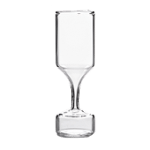
The defense industry demands reliable reserve batteries (also called deferred-action batteries) for the electronic fuse systems of projectile munitions that are stored for years prior to use.
These reserve batteries (or ampoule batteries) extend the shelf life of munitions to 20+ years. Even with this extended shelf life, they can be activated at any time, which is accomplished by separating the electrolyte battery fluid from the active cells until the time of use. When the munition is ready to be detonated, an electrolyte-filled ampoule (typically made of glass) is broken, releasing the electrolyte into an active cell, energizing the battery and causing detonation.
Many lithium reserve batteries are Lithium-Thionyl Chloride (Li-SOCl2) or Lithium Silicon/Iron Disulfide (LiSi-FeS2) based and require precision glass forming and specific glass thicknesses to guarantee that the ampoule breaks in a specific way at a specific time. This ensures that the electrolyte is released into a multi-cell stack at the right time; not too early and not too late. Both types of reserve batteries have similar requirements for a long shelf life with proper activation of the battery on demand.
Precision glass ampoules (sometimes called ampules) are the most common method for storing reserve battery fluid and have been successfully implemented in various munition designs for defense applications.
Fredericks has the ability to customize many key features of glass ampoules for your deferred-action battery:
- Volume – guaranteeing that the internal volume of the ampoule holds the correct amount of electrolyte to meet power and energy needs, and required activation times
- Wall Thickness – ensuring precision wall thicknesses that guarantee the ampoule will break correctly and release the electrolyte at the appropriate time, and not too early or too late
- Shape – assuring that the shape of the ampoule is suited for the appropriate housing, deployment/activation technique, and activation time
- Price – volumes and manufacturability can significantly reduce costs of glass ampoules






